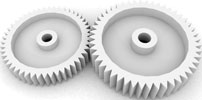

Manufacturing companies are trying to reduce maintenance costs by implementing preventative maintenance programs. These programs normally rely on accurate estimates of equipment working hours, typically set at program inception and rarely updated there-after.
So what is the problem?
This maintenance methodology typically reduces the instances of unexpected equipment breakdown and can prevent considerable production losses. Companies that have effectively implemented this methodology have realised improved equipment availability and reduced breakdowns. They do however have a problem in balancing necessary and unnecessary maintenance efforts.
The problem with schedule-based maintenance is that equipment may be serviced either unnecessarily or too late to prevent equipment failure. One way to ensure that equipment is only serviced when required is to measure actual operating hours and to send the data to the planned maintenance system when maintenance is due. This will ensure that the equipment is maintained only when the defined operating hours have been reached. This method works well when the defined operating hours correspond with the health of the equipment. For instance, when a pump is pumping non-corrosive fluids, it may last longer than the manufacturer’s recommended running hours, but when it is pumping more corrosive fluids it may not last for the total hours before breaking down.
Another way would be to implement dedicated equipment health monitoring instrumentation like vibration measurement. These tools work well and can identify when a piece of equipment is not healthy. Tools like this typically consist of a combination of software and specialised dedicated instruments installed on equipment. Due to the expense of these solutions, they are normally only implemented on critical pieces of equipment, but they add great value.
Most of the above technologies are applied to individual pieces of equipment, which may be pieces of a larger system. This makes it even more difficult to maintain schedules, as taking a component off-line for maintenance may also shut down a major system like a furnace or boiler. Due to the number of equipment components that make up a system, it is difficult to determine if the system is healthy. Only highly experienced engineers are able to identify equipment health using variables from the individual components to form a mental picture of the system health.
In addition to potential unplanned breakdowns, unhealthy equipment or systems also affect equipment performance and efficiency. Unhealthy systems use more energy, waste more materials and can result in substantial product losses.
Equipment health models
What is needed to assist companies is a tool that will not only identify unhealthy equipment before it breaks down, but that can also delay maintenance when equipment is still healthy and can continue operating. If this can be done without installing any dedicated or specialised instrumentation, so much the better.
Luckily, technology has advanced to such a degree that it is possible to monitor equipment health and predict equipment failure. Some of the major companies in South Africa are using, or are contemplating using technology to help them increase equipment performance and reduce maintenance costs. These technologies use the principles of computer modelling, historical data analysis and pattern recognition focused on equipment health to predict equipment failure.
First, one or more equipment health models are built by identifying process and equipment-specific variables that can potentially indicate the health of the equipment. Then historical data is used within the models to build patternsof equipment behaviour. The patterns are optimised by removing data related to breakdowns and other ill-health incidents. This establishes baseline patterns for healthy equipment behaviour. The models are then implemented in real-time and compare behaviour against the pattern.
When the real-time data starts deviating from the healthy pattern, it is an indication of equipment ill-health and steps can be taken. The technology typically also indicates the major variable responsible for the deviation from the healthy pattern, assisting engineers in pin-pointing potential problems. The last step would be to set up alarm limits for deviations.
Different models can be built for different seasons if ambient conditions influence equipment performance or for different raw-material feeds if they affect equipment performance. Different models can also be built depending on different phases of the equipment life-cycle. For instance, equipment will behave differently before and after refurbishment, and so the same model cannot be used in both cases as it may give false alarms.
As this technology uses typical process in combination with standard equipment variables, it takes into account not only variables that indicate the state of individual components, but also of process variables that influence equipment performance. This has the advantage that it can pick up incremental changes over long periods that would not normally be identified by operators or engineers. For instance, increased power use and reduced pressure may indicate that a pump impeller has been eroded and that the pump is close to failure.
Early indications from a number of sites are that this technology can accurately predict imminent equipment failure and reduce unplanned breakdowns. A secondary effect is that equipment as well as process performance is increased and in some instances, planned maintenance cycles can be lengthened considerably.
This technology provides an early warning to the problems that are occurring in real-time. It can be of great benefit for any company that has a mature maintenance approach and a real-time process historian. The main benefits can be summarised as follows:
* Improve asset availability.
* Reduce forced outages.
* Improve predictive maintenance and reduce reactive maintenance.
* Improve the leverage of resources and costs across the fleet.
* Improve operational support to plant staff.
* Capture retiring workforce asset expertise in an automated system.
For more information contact Gerhard Greeff, Bytes Systems Integration, +27 (0)11 205 7000, [email protected], www.bytes.co.za

© Technews Publishing (Pty) Ltd | All Rights Reserved